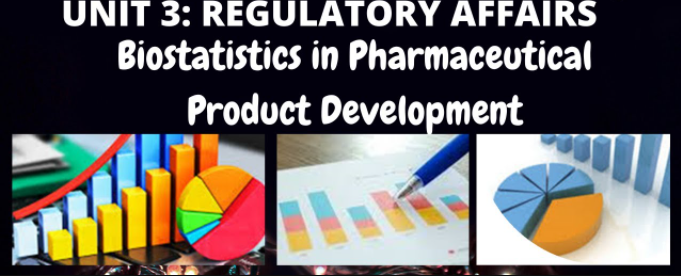Biostatistics in Pharmaceutical Product Development | Industrial Pharmacy
What is Biostatistics?
Statistics is the discipline that concerns the collection, organization, analysis, interpretation and presentation of data. In applying statistics to a scientific, industrial, or social problem.
Biostatistics
Biostatistics is the application of statistics in the development and use of therapeutic drugs and devices in humans and animals.
Biostatistics involve the use of scientific and quantitative procedures in descriptive and inferential statistics to evaluate the quality of evidence in biological sciences. It also involves the statistical processes and methods used for analysing the biological phenomena. Biostatistics is a science that includes designing of biological and experimental study designs as well as synthesis, analysis, and interpretation of data obtained from such studies.
Biostatistics is a wide branch of biological sciences in which the theories in statistics are applied to the living-world problems in health and diseases. It involves various statistical operations, such as designing and conducting biomedical experiments, clinical trials, and development of related computational algorithms. Biostatistics forms an important part in epidemiological research, development of health policies, health economics, public health administration, evidence-based practice in clinical medicine, genomics, proteomics, and development of various pharmaceutical products.
Statisticians often use the method of comparison.
We want to know the effect of a treatment (like the Salk vaccine) on a response (like getting polio).
Compare the responses of a treatment group with a control group.
Biostatistics covers applications and contributions not only from health, medicines and, nutrition but also from fields such as genetics, biology, epidemiology, and many others.
It is mainly consists of various steps like generation of hypothesis, collection of data, and application of statistical analysis.
Any science needs precision for its development. O Precision is all the more important when it comes to health sciences. For precision; facts, observations or measurements have to be expressed in figures.
Pharmaceutical Industry
Applications
- Medicine is essentially an empirical science. It depends on observations and not on theories or theorems.
- As a part of clinical practice or research we deal with many observations, which when systematically arranged, are called Data.
- The process of converting data into information requires a special approach called statistics.
- 'Statistic' means a measured or counted fact or piece of the information, stated as a figure such as height of one person, birth weight of a baby etc.
History
ROLE OF BIOSTATISTICIANS
- Identify and develop treatments for disease and estimate their effects.
- Identify risk factors for diseases.
- Design, monitor, analyze, interpret, and report results of clinical studies.
- Develop statistical methodologies to address questions arising from medical/public health data.
- Locate, define & measure extent of disease
- Ultimate objective
- Improve the health of individual & community
Application and uses of Biostatistics as a science in Physiology
Pharmacology
Biostatistics in clinical trials
- Clinical Trials
- Visit Clinical Trials.gov.
- Statistics in Drug Development
- Study design
- Clinical data
- Statistical modeling
- Other topics
- Statistics in Drug Development
Biostatistics: Responsibilities
- Design the study and develop the protocol.
- Design the randomization algorithm if needed.
- Draft the statistical analysis plan (SAP) Programming the study data based on the SAP: tables/ figures/ listings (TFLs).
- Present the results and write the interpretation of study results in clinical study report (CSR). Statistics in Drug Development




Post a Comment
0 Comments